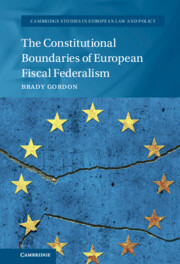Book contents
- The Constitutional Boundaries of European Fiscal Federalism
- Cambridge Studies in European Law and Policy
- The Constitutional Boundaries of European Fiscal Federalism
- Copyright page
- Basic Table of Contents
- Detailed Table of Contents
- Figures
- Acknowledgements
- Table of Cases
- Table of Legislation, Treaties and Conventions
- Abbreviations
- Part I
- Methods and Introduction
- 1 The Constitutional Boundaries of European Fiscal Federalism
- 2 The Maastricht Architecture of European Fiscal Federalism
- 3 The Failure and Abrogation of the Maastricht Model
- 4 Constitutional Criteria for EU Fiscal Federalism
- Part II
- Proposed Directions for Future Research and Reform
- Bibliography
- Index
2 - The Maastricht Architecture of European Fiscal Federalism
from Part I
Published online by Cambridge University Press: 07 April 2022
- The Constitutional Boundaries of European Fiscal Federalism
- Cambridge Studies in European Law and Policy
- The Constitutional Boundaries of European Fiscal Federalism
- Copyright page
- Basic Table of Contents
- Detailed Table of Contents
- Figures
- Acknowledgements
- Table of Cases
- Table of Legislation, Treaties and Conventions
- Abbreviations
- Part I
- Methods and Introduction
- 1 The Constitutional Boundaries of European Fiscal Federalism
- 2 The Maastricht Architecture of European Fiscal Federalism
- 3 The Failure and Abrogation of the Maastricht Model
- 4 Constitutional Criteria for EU Fiscal Federalism
- Part II
- Proposed Directions for Future Research and Reform
- Bibliography
- Index
Summary
Chapter 2 moves from the constitutional foundations of the European legal order to the architecture of fiscal federalism constructed atop them. It investigates where the constitutional principles identified in Chapter 1 inhere in the legal architecture of EMU, and explains the basic principles of economics inscribed for their attainment. The principles of fiscal sovereignty, price stability, and fiscal discipline are shown to penetrate three levels of investigation: The travaux préparatoires and the mandate for EMU (Article 119 TFEU); the allocation of competences in economic policy (Articles 2(3) and 5(1) TFEU); and the technical architecture governing public finance itself (Articles 121-126 TFEU). By those provisions, EU fiscal federalism rests on two principles: (1) Fiscal sovereignty – member state economic/fiscal competences remain outside the EU legal order altogether; and (2) market discipline –member states are exposed to ‘hard budget constraints’ and ‘market discipline’ to ensure fiscal discipline.
Keywords
- Type
- Chapter
- Information
- The Constitutional Boundaries of European Fiscal Federalism , pp. 106 - 136Publisher: Cambridge University PressPrint publication year: 2022



